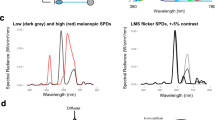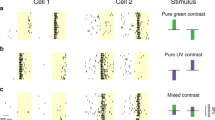Abstract
THE micro-stimulation apparatus1 has been used recently for studying the shapes of the response curves of some of the receptors which take part in human foveal colour vision. It will be remembered that Granit found evidence for seven kinds of ‘modulator’ in the retinæ of such animals as frogs, snakes and rats, which had maximum responses at the following approximate wave-lengths: 6000, 5800, 5400, 5200, 5000, 4600 and 4400 angströms. All these had narrow response curves. In the cat, on the other hand, the response curves appeared to be wider, having legs which were farther apart. Particularly was this the case with the ‘modulators’ produced from ‘dominators’ after the retina had been exposed to red, to green, or to blue lights.
This is a preview of subscription content, access via your institution
Access options
Subscribe to this journal
Receive 51 print issues and online access
$199.00 per year
only $3.90 per issue
Buy this article
- Purchase on Springer Link
- Instant access to full article PDF
Prices may be subject to local taxes which are calculated during checkout
Similar content being viewed by others
References
To be described in Phil. Trans. Roy. Soc.
Author information
Authors and Affiliations
Rights and permissions
About this article
Cite this article
HARTRIDGE, H. Response Curve of the Yellow Receptors of the Human Fovea. Nature 158, 946–948 (1946). https://doi.org/10.1038/158946b0
Issue Date:
DOI: https://doi.org/10.1038/158946b0
Comments
By submitting a comment you agree to abide by our Terms and Community Guidelines. If you find something abusive or that does not comply with our terms or guidelines please flag it as inappropriate.



